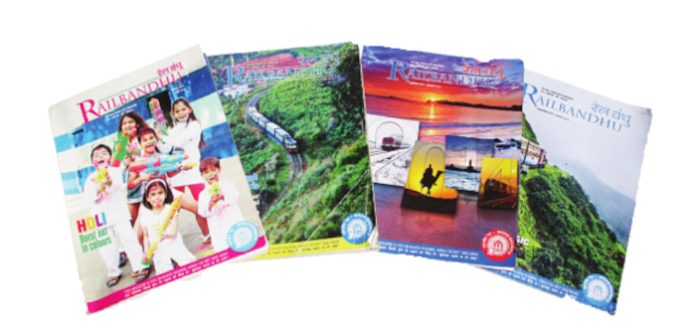
Though Indians are supposedly voracious readers, in recent times, print versions of various magazines in India are already considered an endangered species. More and more industry trends indicate that the top-end reader segment is increasingly shifting towards digital while growth in print appears to be coming from regional and local publishing, which have so far been under-served markets. While this will continue for the urban and youth segments, which are a key target audience for most advertisers, digital is a growing medium, and print a declining one. Trains link the growing urban and rural middle class — a captive audience that could be linked with various magazines including some sponsored by the Indian Railways themselves.
An example of one such project would be Rail Bandhu, the first on- board magazine of the Indian Railways published in association with CMYK Printech, Delhi. The magazine is printed at Thomson Press, Faridabad. On 16 April 2011, which was also the ‘Rail Diwas,’ the inaugural issue of Rail Bandhu was published. The monthly magazine was conceptualized with the specific purpose of bringing the railways closer to its passengers. The magazine is available in all premier trains, which include the Rajdhani, Shatabdi and Duronto Express. The first issue of the magazine was a 100- page publication, with many articles of general interest, including a short story by Ruskin Bond and the lead story on Rabindranath Tagore and how he reportedly lost and found the original manuscript of Gitanjali while travelling on London’s Tube. During
the magazine’s pilot stage, it had a print run of one lakh copies. According to recent reports, the magazine has already reached a readership of 30 lakh which is bigger than any leading news weekly.
According to the chairman of the railway board, “Rail Bandhu was conceptualized for the changing face of the railways. The magazine will therefore reflect the spirit of the frequent traveller, his aspirations in an emergent India. Indian Railways is a microcosm of India’s evolving story. On-board
magazines are supposed to add to the romance and engagement of the journey and add a new dimension to it. Over the last two years, the magazine has earned respect in the market with quality travelogues and informative articles on lifestyle, history, technology, art, culture, sports and films amongst others.”
The railways has already declared the development of tourism in the country a priority. The primary objective of Rail Bandhu is to highlight places of historical importance to visit by tourists. The Indian Railways has been running a couple of special trains for both domestic and international tourists. Likely to provide a variety of interesting stories about the railways at the country level, the publication was to devote a minimum of 30 pages to news, events
or features concerning the railways, while another 30 pages of advertisements were to be published. With such a massive infrastructure in place and readership numbers already looking good, the scope of advertisements and revenue generation in the future seem promising.
The magazine uses good quality glossy paper, colour photographs on almost every page with interesting content and a very reader friendly format. The magazine is also multilingual with content both in English and Hindi which is an important factor in the burgeoning readership of the magazine.
The magazine usually starts with a question and answer section with a Bollywood personality.
Several travelogues of indian tourist destinations follow with instructions of how to reach these places by train. Other sections include historical places, mega-structures, wildlife, astrology and recipes amongst others. In 2012, Rail Bandhu bagged the Best New Travel Magazine Award at the Hospitality India & Explore the World Annual International Awards.
In today’s publishing world, one of the key goals of any publisher is engaging the reader. With so many everyday distractions, it is essential that a magazine hook its readers at the very first opportunity it gets. Rail Bandhu is an interesting example of creating readership and engagement out of nowhere and shows that print remains an interesting option for the general reader.















